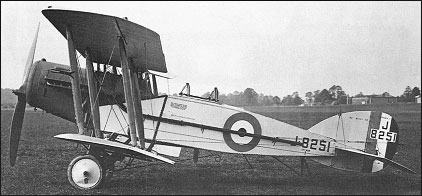|
| The F.2B two-seat fighter-reconnaissance aircraft differed
from the F.2A in having a revised centre fuselage
to provide improved pilot view, an enlarged fuel tank,
increased ammunition capacity for the synchronised
Vickers gun and a modified lower wing affording a
small increase in gross area. New horizontal tail surfaces
of greater span and increased aspect ratio were
introduced, and after the first 150 F.2Bs had been delivered
with the 190hp Rolls-Royce engine - by this
time designated Falcon I - the 220hp Falcon II was
adopted, this being succeeded in turn by the 275hp
Falcon III which powered the majority of the F.2Bs
built. F.2B deliveries began on 13 April 1917, and the success of this type led to the decision to re-equip all
RFC fighter-reconnaissance squadrons with F.2Bs. Production
continued, in the event, until September 1919,
by which time a total number of 4,747 had been completed,
3,126 of these by the parent company. Of the
final batch, 153 were delivered with the 200hp Sunbeam
Arab engine and 18 with the 230hp Siddeley
Puma. When the RAF was re-established on a peacetime
footing, the F.2B was adopted as standard for the
army co-operation role and reinstated in production for
this task as the Mk II, others being refurbished to similar
standards. Fifty structurally revised aircraft delivered
in 1926 were designated as Mk Ills, all surviving
aircraft of this mark being converted in 1928 as Mk IVs.
 | A three-view drawing (1280 x 872) |
| WEIGHTS |
| Take-off weight | 1292 kg | 2848 lb |
| Empty weight | 875 kg | 1929 lb |
| DIMENSIONS |
| Wingspan | 11.96 m | 39 ft 3 in |
| Length | 7.87 m | 26 ft 10 in |
| Height | 2.97 m | 10 ft 9 in |
| Wing area | 37.68 m2 | 405.58 sq ft |
| PERFORMANCE |
| Max. speed | 198 km/h | 123 mph |
| Barry, 12.03.2013 13:06 The Bristol model numbers for the F2A and F2B were in the range 14 - 17. This extremely capable aircraft flew with 14 foreign air forces and was manufactured in 10 British factories and three in the U.S.A. The last delivery was to Mexico and the last in service was withdrawn in 1938 from the RNZAF. One is still flown today by the Shutleworth Trust. reply | | Martin Wilkinson, e-mail, 30.11.2010 21:25 In answer to Michael Gibbon:
The Fe2b was a completely different aeroplane to the Bristol F2b. The Fe2b was a pusher two-seater produced by the Royal Aircraft Factory and was a much more primitive machine. reply | | Michael Gibbon, e-mail, 24.10.2010 19:26 My uncle was shot down on 6 Feb 1917 in what I believe was
a FE2B fighter reconnaissance deployed in France in 1916,
20th Squadron Royal Flying Corps, yet it reports the first batch of these planes arrived after that date, on 13th April. Can anyone please help reply | | Norm Clifford, e-mail, 12.08.2010 05:09 I would like to know the engine difference between the BF with a two blade prop and the BF with a four blader. Regards. reply | |
| | troy, e-mail, 24.02.2010 06:15 Hi,
Would you be able to please tell me your source for the date of 13th april as the delivery date for the 1st batch of F2B? Any help would be veery much appreciated.
Many Thanks,
Troy reply |
|
Do you have any comments?
|
| 
COMPANY
PROFILE
All the World's Rotorcraft
|







